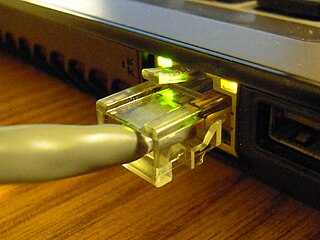
Ethernet is a family of wired computer networking technologies commonly used in local area networks (LAN), metropolitan area networks (MAN) and wide area networks (WAN). It was commercially introduced in 1980 and first standardized in 1983 as IEEE 802.3. Ethernet has since been refined to support higher bit rates, a greater number of nodes, and longer link distances, but retains much backward compatibility. Over time, Ethernet has largely replaced competing wired LAN technologies such as Token Ring, FDDI and ARCNET.
IEEE 802.3 is a working group and a collection of standards defining the physical layer and data link layer's media access control (MAC) of wired Ethernet. The standards are produced by the working group of Institute of Electrical and Electronics Engineers (IEEE). This is generally a local area network (LAN) technology with some wide area network (WAN) applications. Physical connections are made between nodes and/or infrastructure devices by various types of copper or fiber cable.
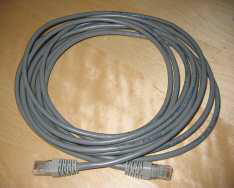
Ethernet over twisted-pair technologies use twisted-pair cables for the physical layer of an Ethernet computer network. They are a subset of all Ethernet physical layers.
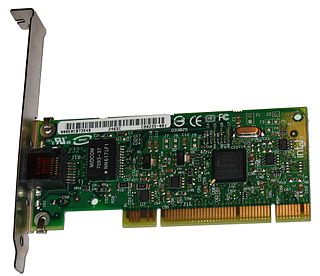
In computer networking, Gigabit Ethernet is the term applied to transmitting Ethernet frames at a rate of a gigabit per second. The most popular variant, 1000BASE-T, is defined by the IEEE 802.3ab standard. It came into use in 1999, and has replaced Fast Ethernet in wired local networks due to its considerable speed improvement over Fast Ethernet, as well as its use of cables and equipment that are widely available, economical, and similar to previous standards. The first standard for faster 10 Gigabit Ethernet was approved in 2002.
XENPAK is a multisource agreement (MSA), instigated by Agilent Technologies and Agere Systems, that defines a fiber-optic or wired transceiver module which conforms to the 10 Gigabit Ethernet (10GbE) standard of the Institute of Electrical and Electronics Engineers (IEEE) 802.3 working group. The MSA group received input from both transceiver and equipment manufacturers during the definition process. XENPAK has been replaced by more compact devices providing the same functionality.

Power over Ethernet (PoE) describes any of several standards or ad hoc systems that pass electric power along with data on twisted-pair Ethernet cabling. This allows a single cable to provide both a data connection and enough electricity to power networked devices such as wireless access points (WAPs), IP cameras and VoIP phones.
10 Gigabit Attachment Unit Interface is a standard for extending the XGMII between the MAC and PHY layer of 10 Gigabit Ethernet (10GbE) defined in Clause 47 of the IEEE 802.3 standard. The name is a concatenation of the Roman numeral X, meaning ten, and the initials of "Attachment Unit Interface".
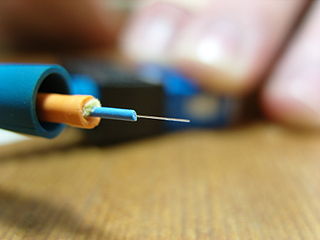
Multi-mode optical fiber is a type of optical fiber mostly used for communication over short distances, such as within a building or on a campus. Multi-mode links can be used for data rates up to 800 Gbit/s. Multi-mode fiber has a fairly large core diameter that enables multiple light modes to be propagated and limits the maximum length of a transmission link because of modal dispersion. The standard G.651.1 defines the most widely used forms of multi-mode optical fiber.

The physical-layer specifications of the Ethernet family of computer network standards are published by the Institute of Electrical and Electronics Engineers (IEEE), which defines the electrical or optical properties and the transfer speed of the physical connection between a device and the network or between network devices. It is complemented by the MAC layer and the logical link layer. An implementation of a specific physical layer is commonly referred to as PHY.
Ethernet in the first mile (EFM) refers to using one of the Ethernet family of computer network technologies between a telecommunications company and a customer's premises. From the customer's point of view, it is their first mile, although from the access network's point of view it is known as the last mile.
Howard Johnson is an electrical engineer, known for his consulting work and commonly referenced books on the topic of signal integrity, especially for high speed electronic circuit design. He served as the chief technical editor for Fast Ethernet and Gigabit Ethernet standardisation, and was recognized by the IEEE as an "Outstanding Contributor" to the IEEE P802.3z Gigabit Task Force.
40 Gigabit Ethernet (40GbE) and 100 Gigabit Ethernet (100GbE) are groups of computer networking technologies for transmitting Ethernet frames at rates of 40 and 100 gigabits per second (Gbit/s), respectively. These technologies offer significantly higher speeds than 10 Gigabit Ethernet. The technology was first defined by the IEEE 802.3ba-2010 standard and later by the 802.3bg-2011, 802.3bj-2014, 802.3bm-2015, and 802.3cd-2018 standards. The first succeeding Terabit Ethernet specifications were approved in 2017.
Carrier Ethernet is a marketing term for extensions to Ethernet for communications service providers that utilize Ethernet technology in their networks.
The 10 Gbit/s Ethernet Passive Optical Network standard, better known as 10G-EPON allows computer network connections over telecommunication provider infrastructure. The standard supports two configurations: symmetric, operating at 10 Gbit/s data rate in both directions, and asymmetric, operating at 10 Gbit/s in the downstream direction and 1 Gbit/s in the upstream direction. It was ratified as IEEE 802.3av standard in 2009. EPON is a type of passive optical network, which is a point-to-multipoint network using passive fiber-optic splitters rather than powered devices for fan-out from hub to customers.

The Ethernet Alliance was incorporated in the US state of California in August 2005 and officially launched in January 2006 as a non-profit industry consortium to promote and support Ethernet. The objectives were to provide an unbiased, industry-based source of educational information; to ensure interoperability among disparate, standards-based components and systems; to support the development of standards that support Ethernet technology; and to bring together the Ethernet industry to collaborate on the future of the technology.
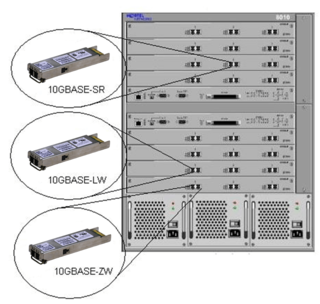
10 Gigabit Ethernet is a group of computer networking technologies for transmitting Ethernet frames at a rate of 10 gigabits per second. It was first defined by the IEEE 802.3ae-2002 standard. Unlike previous Ethernet standards, 10GbE defines only full-duplex point-to-point links which are generally connected by network switches; shared-medium CSMA/CD operation has not been carried over from the previous generations of Ethernet standards so half-duplex operation and repeater hubs do not exist in 10GbE. The first standard for faster 100 Gigabit Ethernet links was approved in 2010.
Terabit Ethernet (TbE) is Ethernet with speeds above 100 Gigabit Ethernet. The 400 Gigabit Ethernet and 200 Gigabit Ethernet standard developed by the IEEE P802.3bs Task Force using broadly similar technology to 100 Gigabit Ethernet was approved on December 6, 2017. On February 16, 2024 the 800 Gigabit Ethernet standard developed by the IEEE P802.3df Task Force was approved.
EPON Protocol over Coax, or EPoC, refers to the transparent extension of an Ethernet passive optical network (EPON) over a cable operator's hybrid fiber-coax (HFC) network. From the service provider's perspective the use of the coax portion of the network is transparent to EPON protocol operation in the optical line terminal (OLT) thereby creating a unified scheduling, management, and quality of service (QoS) environment that includes both the optical and coax portions of the network. The IEEE 802.3 Ethernet Working Group initiated a standards process with the creation of an EPoC Study Group in November 2011. EPoC adds to the family of IEEE 802.3 Ethernet in the First Mile (EFM) standards.
25 Gigabit Ethernet and 50 Gigabit Ethernet are standards for Ethernet connectivity in a datacenter environment, developed by IEEE 802.3 task forces 802.3by and 802.3cd and are available from multiple vendors.
IEEE 802.3bz, NBASE-T and MGBASE-T are standards released in 2016 for Ethernet over twisted pair at speeds of 2.5 and 5 Gbit/s. These use the same cabling as the ubiquitous Gigabit Ethernet, yet offer higher speeds. The resulting standards are named 2.5GBASE-T and 5GBASE-T.








